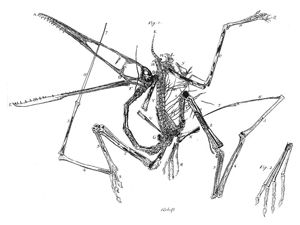home > natural history
Pterodactylus antiquus
"antique wing finger"
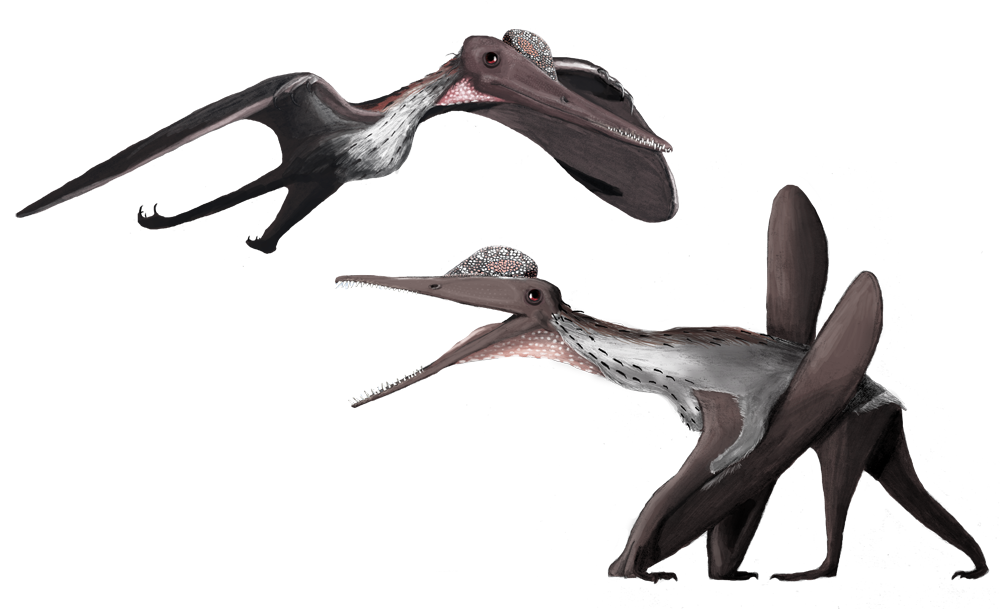
Pterodactylus antiquus is a small, unassuming pterosaur from Germany. All known specimens were small, ranging from tiny flaplings to sub-adults. No fully mature specimens are known, but enough of the young ones are that we can tell they bred seasonally, and similarly-sized specimens can be grouped together in year classes. The shape of the skull and teeth change pretty dramatically: flaplings have short, blunt snouts while those of adults are long and narrow. This indicates that pterosaurs like Pterodactylus inhabited different ecological niches as they aged. Perhaps the niches of flapling Pterodactylus overlapped with the similar-looking flaplings of related pterosaurs (which were long tangled together with Pterodactylus in a confusing taxonomy of many species) that lived in the same time and place, like Germanodactylus, Gnathosaurus, and the filter-feeding Ctenochasma.
What's especially interesting about Pterodactylus is its status as the first pterosaur ever found. Its fossil remains came to light in the middle of a pretty fascinating period of scientific growth in paleontology, as fossils began to be recognized as the remains of extinct organisms rather than interesting rock patterns or the bones of fantastic creatures that still inhabited some distant jungle.
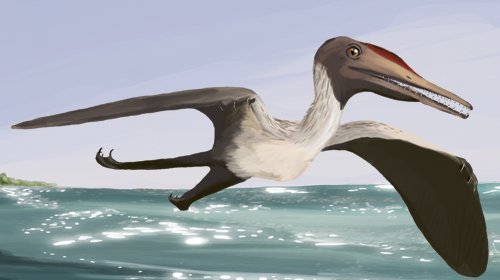
Sometime during the 18th Century, the first Pterodactylus specimen was uncovered from the lithographic limestone near Eichstätt, today a part of Bavaria, Germany but at the time a semi-independent state of the Holy Roman Empire. The fossil, a complete skeleton crushed flat, came into the possession of the Count John Freiderich Ferdinand of neighboring Pappenheim, who donated it to the nature cabinet of Elector Charles Theodore in Mannheim. Nature cabinets and cabinets of curiosity were the precursors of the modern concept of the natural history museum, a room or series of rooms in which wealthy nobles with an interest in science could display and organize their private collections. Theodore's nature cabinet was curated by a Florentine scholar named Cosimo Collini, one-time secretary and friend of Voltaire. Collini took an interest in the strange fossil when he began his tenure at Mannheim in 1757, and published a description of it in 1784. The fossil animal was like nothing seen before--a bird-like head and neck, a small, mammal-like body and tail, long, reptilian claws and teeth and, most curiously, one incredibly long finger on each hand. Collini was at a loss, totally unable to identify even its class. At the time, Cuvier had not yet popularized the notion that fossil animals were new forms of life, rather than differently proportioned representatives of living animal types. Unable to sort out the fossils chimerical nature and identify its known modern forms, Collini speculated that such a bizarre animals must exist in the mysterious depths of the sea to have avoided scientific notice for so long. He did note that in some ways it was bird-like, and in some ways appeared bat-like, but rightly concluded it was not a close relative of either. For his description, Collini enlisted Egid Verhelst II to create a copper engraving of the fossil as a plate to accompany his paper. Verhelst thus became the first person to ever draw a pterosaur.
The German-French scientist Johann Hermann became aware of the fossil sometime after Collini published his description. In 1800, Hermann was concerned because Napoleon Bonaparte's occupying army was confiscating any interesting or culturally significant German artifacts they came across. Hermann figured that the fossil would likely be taken from the Mannheim palace nature cabinet, and sent to French scientists for study. Hermann wrote a letter to the top French scientist of the day, expert anatomist Georges Cuvier, letting him know that the strangest fossil he'd ever seen was likely coming his way. Hermann became the great-grandfather of all pterosaur-related paleoart by providing the first ever life illustration of the small creature. He decided that the long fingers supported a wing membrane, and that the creature was a long-snouted bat-like mammal. Furthermore, he pointed out that some stories coming out of China indicated that similar creatures might still be alive in the jungle there. Cuvier replied that the China bit was total nonsense, but was intrigued by Hermann's diagrams. He agreed the finger probably formed a wing, though he disagreed on Hermann's classification, believing it to be a reptile rather than a mammal. Cuvier eagerly awaited the opportunity to study it.
He was waiting a while. Napoleon had not actually raided the nature cabinet. Elector Theodore had died in February of 1799, and in 1802, his entire natural history collection was brought to Munich, much to the dismay of Cosimo Collini, who felt a personal connection and obligation to its care. Once in Munich, the Baron Johann von Moll managed to convince the French to grant the Bavarian collections a exemption from being confiscated. By the time Cuvier learned of the fossils whereabouts and wrote to von Moll asking to study the fossil, von Moll replied that the fossil was missing. This didn't deter Cuvier, who published his own description in 1809 based on the previous reports from Collini and Hermann. Without ever having seen the specimen, he gave it a name: Petro-Dactyle, literally "stone finger." In a later re-print, Cuvier made it seem like this was a spelling error, and emended the name to Ptero-Dactyle, "wing finger."
The saga of the perpetually absent fossil continued. Moll could not find it in his collection because other scientists had already checked it out for personal study: first Johann Hermann Blumenbach, who decided it was a type of shorebird in 1807. Blumenbach is also notable as one of the first scientists to ever study a similar perplexing chimera of an animal, the platypus. Next, Samuel von Sömmerring studied the fossil in depth, concluding with a lecture on December 27,1810. Shortly thereafter, he wrote to Cuvier apologizing for the situation, claiming that he had only just been told of Cuvier's request for information. Nevertheless, he published the contents of his lecture in 1812, and took the opportunity to give it his own name, Ornithocephalus antiquus. Sömmering disagreed vehemently with Cuvier regarding the identity of the fossil, arguing that it was a link between birds and bats, not a reptile (though a link in "affinity" rather than the modern evolutionary concept of relatedness between animal types). Sömmering notoriously misidentified several portions of the Pterodactylus skeleton, especially in a restoration of a second specimen that he described in 1817 as a new species (but now recognized as a juvenile or "flapling"). It wasn't until the 1860s that general consensus was reached and Cuvier's view won out: pterodactyls were reptiles, until then, several other theories were proposed including that it was a big-eared, bat-like marsupial or even an amphibian, with flippers instead of wings.
In the following decades, many more pterosaur specimens were found, most of them assigned as species of Pterodactylus (even gigantic British forms like Ornithocheirus). Today, most of those have been assigned to other genera or recognized as juveniles, for a complete breakdown of the confused taxonomy, see the Wikipedia article I had a hand in creating. One thing to note is the use of family-level ranked names based on Pterodactylus. Hermann von Meyer named a 'family' for Pterodactylus, despite it being the only genus of its kind, as was the fashion in those days. But, he named it Pterodactyli, rather than Pterodactylidae as would be mandated by the current code of zoological nomenclature. Napoleon's nephew, Charles Lucian Bonaparte, was himself a naturalist and interested in the pterosaurs specimens coming to light in the early 19th century. Bonaparte took the opportunity to emend Meyer's name to Pterodactylidae. This type of emendation is allowed by the ICZN, and some modern sources listing Bonaparte 1838 as the authority which named Pterodactylidae are in error: actually, though Bonaparte corrected the spelling, the credit should still be attributed to von Meyer 1830. So should the superfamily which contains Pterodactylidae, which following the principle of coordination must be named Pterodactyloidea Meyer 1830, rather than Ctenochasmatoidea, which is almost universally and incorrectly used. This oversight is understandable when you realize that the suborder named Pterodactyloidea and used for all short-tailed pterosaurs is actually an entirely different group that just happens to have the same name, coined by Pleininger in 1901. The ICZN doesn't govern names above superfamily, so it's perfectly acceptable (but certainly confusing) for the superfamily Pterodactyloidea to belong to the order Pterodactyloidea.
Pterodactylus is tied up in the history of the science of paleontology, paleoart (at least in terms of how ancient life was interpreted and restored), the history of museums, and with some pretty great and/or notable 18th and 19th century characters. And it's still yielding secrets today that help us understand key aspects of pterosaur biology and life appearance. Not bad for a 230 year old slab of rock and the crushed bones of a deep sea dragon/bat-bird link/flying marsupial/flying reptile/well... whatever you want to call a pterosaur.
Image Details:
Media: Graphite, digital coloring in Adobe Photoshop
License:
ALL RIGHTS RESERVED
DESCRIPTION
Length: 50cm (1.6ft)
Wingspan: 1.2m (4ft)
Weight: 1kg (2.2lbs)
Location: Solnhofen Limestone, Bavaria, Germany
Time: Tithonian age, Late Jurassic (150 Ma)
CLASSIFICATION
Kingdom: Animalia
Phylum: Chordata
Class: Stem-Aves
Order: Pterosauria
Family: Pterodactylidae
Genus: Pterodactylus
Species: P. antiquus
SYSTEMATICS
Sauropsida
Diapsida
Archosauria
Ornithosuchia
Pterosauria
Pterodactyloidea
Pterodactylidae
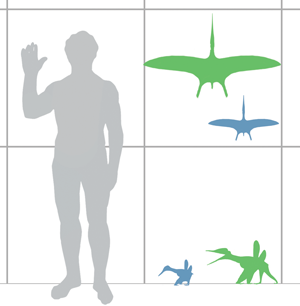
Scale chart, juvenile type specimen (blue) and adult size (green).
Copper engraving of the holotype specimen, BSP No. AS.I.739, by Egid Verhelst II, commissioned by Cosimo Collini and published in 1784 (click to enlarge).
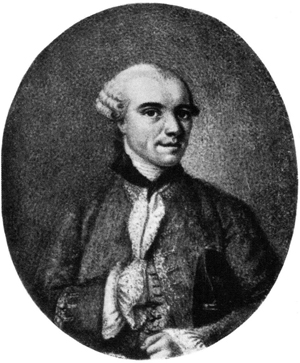
Cosimo Collini
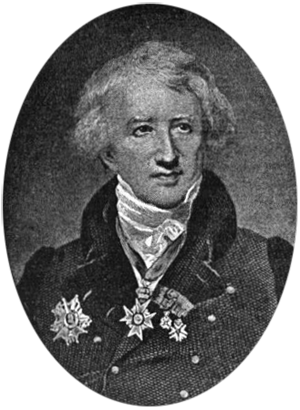
Georges Cuvier
